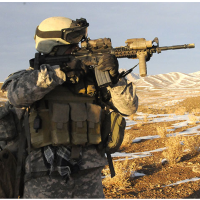The Rise of the U.S. Special Operations Command
 Special Forces in Afghanistan (photo: U.S. Army)
Special Forces in Afghanistan (photo: U.S. Army)
U.S. Special Operations Command (SOCOM) has become perhaps the most important component within the Department of Defense, taking on the responsibility of executing the Obama administration’s new policy for thwarting terrorism threats.
Last year, President Barack Obama established the U.S. Defense Strategic Guidance, which made clear that the days of large-scale invasions (and occupations) are over, in favor of small, lighter military operations best handled by SOCOM and its counterterrorism wing, Joint Special Operations Command (JSOC).
One of the clearest indicators of just how important SOCOM is today can be found in budget plans. At a time when the Pentagon has been told to make do with less, SOCOM will continue to grow in the coming years.
SOCOM is expected to expand by 7.5%, from 66,100 civilian and military personnel in 2011 to 71,100 by 2015.
It’s taken three decades, but Special Ops now enjoy most-favored military sector prominence. Both SOCOM and JSOC were first established in the 1980s, in the wake of the failed hostage rescue mission in Iran.
Since then, Special Ops have played roles in the 1983 invasion of Grenada, the 1989 invasion of Panama and the kidnapping of Manuel Noriega, the 1991 Gulf War, the 1993 operation to arrest Mohamed Farrah Aidid in Somalia, classified missions in Bosnia and Kosovo (1996-2002), as well as the post-9/11 wars in Afghanistan and Iraq.
-Noel Brinkerhoff
To Learn More:
The Tip of the Spear: US Special Operations Forces (by Laleh Khalili, Al Jazeera)
Light Footprints: the Future of American Military Intervention (by Fernando M. Luján, Center for a New American Security) (pdf)
- Top Stories
- Unusual News
- Where is the Money Going?
- Controversies
- U.S. and the World
- Appointments and Resignations
- Latest News
- Trump to Stop Deportations If…
- Trump Denounces World Series
- What If China Invaded the United States?
- Donald Trump Has a Mental Health Problem and It Has a Name
- Trump Goes on Renaming Frenzy






Comments